New Frontiers in the Digital Restoration of Hidden Texts in Manuscripts: A Review of the Technical Approaches
Abstract
1. Introduction
2. Accessibility of Libraries and Best Practices
3. UV Photography
4. Multispectral Imaging (MSI) and Hyperspectral Imaging (HSI)
5. Macro X-ray Fluorescence (XRF) Imaging
6. X-ray Tomography
7. Infrared Thermography (IRT)
8. Terahertz (THz) Imaging
9. Photoacoustic Imaging
10. Not-Conventional Sources (Synchrotron Radiation, Ion Beam Analysis (IBA) and Neutron)
11. Conclusions
Author Contributions
Funding
Data Availability Statement
Acknowledgments
Conflicts of Interest
Correction Statement
References
- Schettino, P.; Pietroni, E.; D’annibale, E. Re-Thinking Visitor Experience with Ancient Manuscripts via the Holographic Showcase: The Case of the Codex4D Project and Its First Public Results from a Mixed-Method Evaluation In Situ. Heritage 2023, 6, 6035–6065. [Google Scholar] [CrossRef]
- Tonazzini, A.; Salerno, E.; Abdel-Salam, Z.A.; Harith, M.A.; Marras, L.; Botto, A.; Campanella, B.; Legnaioli, S.; Pagnotta, S.; Poggialini, F.; et al. Analytical and mathematical methods for revealing hidden details in ancient manuscripts and paintings: A review. J. Adv. Res. 2019, 17, 31–42. [Google Scholar] [CrossRef] [PubMed]
- Orazi, N. Mid-wave Infrared Reflectography and Thermography for the Study of Ancient Books: A Review. Stud. Conserv. 2020, 65, 437–449. [Google Scholar] [CrossRef]
- Pottier, F.; Michelin, A.; Robinet, L. Recovering illegible writings in fire-damaged medieval manuscripts through data treatment of UV-fluorescence photography. J. Cult. Herit. 2018, 36, 183–190. [Google Scholar] [CrossRef]
- Cosentino, A. Practical notes on ultraviolet technical photography for art examination. Conserv. Patrim. 2015, 21, 53–62. [Google Scholar] [CrossRef]
- Pronti, L.; Perino, M.; Cursi, M.; Santarelli, M.L.; Felici, A.C.; Bracciale, M.P. Characterization and Digital Restauration of XIV-XV Centuries Written Parchments by Means of Nondestructive Techniques: Three Case Studies. J. Spectrosc. 2018, 2018, 2081548. [Google Scholar] [CrossRef]
- Bearman, G.H.; Spiro, S.I. Archaeological Applications of Advanced Imaging Techniques. Biblic. Archaeol. 1996, 59, 56–66. [Google Scholar] [CrossRef][Green Version]
- Chabries, D.M.; Booras, S.W.; Bearman, G.H. Imaging the past: Recent applications of multispectral imaging technology to deciphering manuscripts. Antiquity 2003, 77, 359–372. [Google Scholar] [CrossRef]
- Chabries, D.M.; Booras, S.W.; Bikai, P. The Petra Scrolls. In Proceedings of the Image Processing, Image Quality, Image Capture Systems Conference (PICS), Montréal, QC, Canada, 22–25 April 2001. [Google Scholar]
- Booras, S.W.; Seely, D.R. Multispectral imaging of the Herculaneum papyri. Cronache Ercolanesi 1999, 29, 95–100. [Google Scholar]
- Macfarlane, R.; Del Mastro, G.; Antoni, A.; Booras, S. Update Report on the Use of the Multi-spectral images of the Herculaneum papyri. In Proceedings of the XXIV International Congress of Papyrology, Helsinki, Finland, 1–7 August 2004; The Finnish Society of Sciences and Letters: Helsinki, Finland, 2007; pp. 579–586. [Google Scholar]
- Knox, K.T.; Dickinson, C.; Wei, L.; Easton, R.L., Jr.; Johnston, R.H. Multispectral imaging of the Archimedes palimpsest. In Proceedings of the Image Processing, Image Quality, Image Capture, Systems Conference (PICS), Montreal, QC, Canada, 22–25 April 2001; pp. 206–210. [Google Scholar]
- Attas, E.M. Enhancement of Document Legibility Using Spectroscopic Imaging. Archivaria 2004, 57, 131–145. [Google Scholar]
- MacDonald, L.; Giacometti, A.; Campagnolo, A.; Robson, S.; Weyrich, T.; Terras, M.; Gibson, A. Multispectral Imaging of Degraded Parchment. In Computational Color Imaging; Tominaga, S., Schettini, R., Trémeau, A., Eds.; Lecture Notes in Computer Science; Springer: Berlin/Heidelberg, Germany, 2013; Volume 7786, pp. 143–157. [Google Scholar] [CrossRef]
- Alexopoulou, A.A.; Kaminari, A.-A.; Panagopoulos, A.; Pöhlmann, E. Multispectral documentation and image processing analysis of the papyrus of tomb II at Daphne, Greece. J. Archaeol. Sci. 2013, 40, 1242–1249. [Google Scholar] [CrossRef]
- Gibson, A.; Piquette, K.E.; Bergmann, U.; Christens-Barry, W.; Davis, G.; Endrizzi, M.; Fan, S.; Farsiu, S.; Fitzgerald, A.; Griffiths, J.; et al. An assessment of multimodal imaging of subsurface text in mummy cartonnage using surrogate papyrus phantoms. Herit. Sci. 2018, 6, 7. [Google Scholar] [CrossRef]
- Easton, R.; Knox, K.; Christens-Barry, W. Multispectral imaging of the Archimedes palimpsest. In Proceedings of the 32nd Applied Imagery Pattern Recognition Workshop, Washington, DC, USA, 15–17 October 2003; pp. 111–116. [Google Scholar]
- Knox, K.T. Enhancement of overwritten text in the Archimedes Palimpsest. In Electronic Imaging; Stork, D.G., Coddington, J., Eds.; SPIE: San Jose, CA, USA, 2008; p. 681004. [Google Scholar] [CrossRef]
- Christens-Barry, W.A.; Boydston, K.; France, F.G.; Knox, K.T.; Easton, R.L., Jr.; Toth, M.B. Camera system for multispectral imaging of documents. In IS&T/SPIE Electronic Imaging; Bodegom, E., Nguyen, V., Eds.; SPIE: San Jose, CA, USA, 2009; p. 724908. [Google Scholar]
- Easton, R.L., Jr.; Knox, K.T.; Christens-Barry, W.A.; Boydston, K.; Toth, M.B.; Emery, D.; Noel, W. Standardized system for multispectral imaging of palimpsests. In IS&T/SPIE Electronic Imaging; Stork, D.G., Coddington, J., Bentkowska-Kafel, A., Eds.; SPIE: San Jose, CA, USA, 2010; p. 75310D. [Google Scholar] [CrossRef]
- Bloechl, K.; Hamlin, H.; Easton, R.L., Jr. Text recovery from the ultraviolet-fluorescent spectrum for treatises of the Archimedes Palimpsest. In IS&T/SPIE Electronic Imaging; Stork, D.G., Coddington, J., Bentkowska-Kafel, A., Eds.; SPIE: San Jose, CA, USA, 2010; p. 753109. [Google Scholar] [CrossRef]
- Knox, K.T.; Easton, R.L., Jr.; Christens-Barry, W.A.; Boydston, K. Recovery of handwritten text from the diaries and papers of David Livingstone. In IS&T/SPIE Electronic Imaging; SPIE: San Francisco, CA, USA, 2011; p. 786909. [Google Scholar] [CrossRef]
- Jones, C.; Duffy, C.; Gibson, A.; Terras, M. Understanding multispectral imaging of cultural heritage: Determining best practice in MSI analysis of historical artefacts. J. Cult. Herit. 2020, 45, 339–350. [Google Scholar] [CrossRef]
- Rapantzikos, K.; Balas, C. Hyperspectral imaging: Potential in non-destructive analysis of palimpsests. In Proceedings of the IEEE International Conference on Image Processing 2005, Genova, Italy, 14 September 2005. [Google Scholar]
- Snijders, L.; Zaman, T.; Howell, D. Using hyperspectral imaging to reveal a hidden precolonial Mesoamerican codex. J. Archaeol. Sci. Rep. 2016, 9, 143–149. [Google Scholar] [CrossRef]
- Kim, S.J.; Deng, F.; Brown, M.S. Visual enhancement of old documents with hyperspectral imaging. Pattern Recognit. 2011, 44, 1461–1469. [Google Scholar] [CrossRef]
- Pouyet, E.; Devine, S.; Grafakos, T.; Kieckhefer, R.; Salvant, J.; Smieska, L.; Woll, A.; Katsaggelos, A.; Cossairt, O.; Walton, M. Revealing the biography of a hidden medieval manuscript using synchrotron and conventional imaging techniques. Anal. Chim. Acta 2017, 982, 20–30. [Google Scholar] [CrossRef]
- Tournié, A.; Fleischer, K.; Bukreeva, I.; Palermo, F.; Perino, M.; Cedola, A.; Andraud, C.; Ranocchia, G. Ancient Greek text concealed on the back of unrolled papyrus revealed through shortwave-infrared hyperspectral imaging. Sci. Adv. 2019, 5, eaav8936. [Google Scholar] [CrossRef]
- Almaviva, S.; Fantoni, R.; Colao, F.; Puiu, A.; Bisconti, F.; Nicolai, V.F.; Romani, M.; Cascioli, S.; Bellagamba, S. LIF/Raman/XRF non-invasive microanalysis of frescoes from St. Alexander catacombs in Rome. Spectrochim. Acta Part A Mol. Biomol. Spectrosc. 2018, 201, 207–215. [Google Scholar] [CrossRef]
- Nevin, A.; Spoto, G.; Anglos, D. Laser spectroscopies for elemental and molecular analysis in art and archaeology. Appl. Phys. A 2011, 106, 339–361. [Google Scholar] [CrossRef]
- Starynska, A.; Messinger, D.; Kong, Y. Revealing a history: Palimpsest text separation with generative networks. Int. J. Doc. Anal. Recognit. 2021, 24, 181–195. [Google Scholar] [CrossRef]
- Perino, M.; Ginolfi, M.; Felici, A.C.; Rosellini, M. A deep learning experiment for semantic segmentation of overlapping characters in palimpsests. In Proceedings of the IMEKO TC4 International Conference on Metrology for Archaeology and Cultural Heritage, Rome, Italy, 19–21 October 2023; pp. 825–829. [Google Scholar] [CrossRef]
- Ghigo, T.; Rabin, I.; Buzi, P. Black Egyptian inks in Late Antiquity: New insights on their manufacture and use. Archaeol. Anthr. Sci. 2020, 12, 70. [Google Scholar] [CrossRef]
- Taccetti, F.; Castelli, L.; Czelusniak, C.; Giambi, F.; Manetti, M.; Massi, M.; Mazzinghi, A.; Ruberto, C.; Arneodo, F.; Torres, R.; et al. Novel implementation of the INFN-CHNet X-ray fluorescence scanner for the study of ancient photographs, archaeological pottery, and rock art. Rend. Lincei. Sci. Fis. Nat. 2023, 34, 515–522. [Google Scholar] [CrossRef]
- Perino, M.; Pronti, L.; Di Forti, L.G.; Romani, M.; Taverna, C.; Massolo, L.; Manzari, F.; Cestelli-Guidi, M.; Nucara, A.; Felici, A.C. Revealing Artists’ Collaboration in a 14th Century Manuscript by Non-Invasive Analyses. Minerals 2021, 11, 771. [Google Scholar] [CrossRef]
- Miguel, C.; Bottura-Scardina, S.; Bottaini, C.; Valadas, S.; Candeias, A.; Bilou, F. The Power of Combining MA-XRF, Infrared Reflectography and Digital Microscopy to Unveil the Production of the 16th Century Illuminated Charter of Évora: What May Be Hidden under a Painted Surface? Heritage 2022, 5, 286–296. [Google Scholar] [CrossRef]
- Mazzinghi, A.; Ruberto, C.; Castelli, L.; Ricciardi, P.; Czelusniak, C.; Giuntini, L.; Mandò, P.A.; Manetti, M.; Palla, L.; Taccetti, F. The importance of being little: MA-XRF on manuscripts on a Venetian island. X-ray Spectrom. 2020, 50, 272–278. [Google Scholar] [CrossRef]
- Magkanas, G.; Bagán, H.; Sistach, M.; García, J. Illuminated manuscript analysis methodology using MA-XRF and NMF: Application on the Liber Feudorum Maior. Microchem. J. 2021, 165, 106112. [Google Scholar] [CrossRef]
- Watteeuw, L.; Van Bos, M.; Gersten, T.; Vandermeulen, B.; Hameeuw, H. An applied complementary use of macro X-ray fluorescence scanning and multi-light reflectance imaging to study Medieval Illuminated Manuscripts. The Rijmbijbel of Jacob van Maerlant. Microchem. J. 2020, 155, 104582. [Google Scholar] [CrossRef]
- Ricciardi, P.; Legrand, S.; Bertolotti, G.; Janssens, K. Macro X-ray fluorescence (MA-XRF) scanning of illuminated manuscript fragments: Potentialities and challenges. Microchem. J. 2016, 124, 785–791. [Google Scholar] [CrossRef]
- Tibúrcio, C.; Valadas, S.; Cardoso, A.; Candeias, A.; Barreira, C.; Miguel, C. On the use of EDXRF and UV–Vis FORS to unveil the production of two illuminated manuscripts from the fifteenth century portuguese royal court. Microchem. J. 2019, 153, 104455. [Google Scholar] [CrossRef]
- Ragib, Y.; Bat-Yehouda, M.Z. Les encres noires au Moyen Age (jusqu’a 1600). Stud. Islam. 1986, 64, 170. [Google Scholar] [CrossRef]
- Duivenvoorden, J.R.; Käyhkö, A.; Kwakkel, E.; Dik, J. Hidden library: Visualizing fragments of medieval manuscripts in early-modern bookbindings with mobile macro-XRF scanner. Herit. Sci. 2017, 5, 6. [Google Scholar] [CrossRef]
- Michelin, A.; Pottier, F.; Andraud, C. 2D macro-XRF to reveal redacted sections of French queen Marie-Antoinette secret correspondence with Swedish count Axel von Fersen. Sci. Adv. 2021, 7, eabg4266. [Google Scholar] [CrossRef]
- Romano, F.P.; Puglia, E.; Caliri, C.; Pavone, D.P.; Alessandrelli, M.; Busacca, A.; Fatuzzo, C.G.; Fleischer, K.J.; Pernigotti, C.; Preisler, Z.; et al. Layout of ancient Greek papyri through lead-drawn ruling lines revealed by Macro X-ray Fluorescence Imaging. Sci. Rep. 2023, 13, 6582. [Google Scholar] [CrossRef]
- Seales, W.B.; Parker, C.S.; Segal, M.; Tov, E.; Shor, P.; Porath, Y. From damage to discovery via virtual unwrapping: Reading the scroll from En-Gedi. Sci. Adv. 2016, 2, e1601247. [Google Scholar] [CrossRef]
- Bukreeva, I.; Mittone, A.; Bravin, A.; Festa, G.; Alessandrelli, M.; Coan, P.; Formoso, V.; Agostino, R.G.; Giocondo, M.; Ciuchi, F.; et al. Virtual unrolling and deciphering of Herculaneum papyri by X-ray phase-contrast tomography. Sci. Rep. 2016, 6, 27227. [Google Scholar] [CrossRef]
- Mocella, V.; Brun, E.; Ferrero, C.; Delattre, D. Revealing letters in rolled Herculaneum papyri by X-ray phase-contrast imaging. Nat. Commun. 2015, 6, 5895. [Google Scholar] [CrossRef]
- Baum, D.; Lindow, N.; Hege, H.-C.; Lepper, V.; Siopi, T.; Kutz, F.; Mahlow, K.; Mahnke, H.-E. Revealing hidden text in rolled and folded papyri. Appl. Phys. A 2017, 123, 171. [Google Scholar] [CrossRef]
- Liu, C.; Rosin, P.L.; Lai, Y.-K.; Hu, W. Robust Virtual Unrolling of Historical Parchment XMT Images. IEEE Trans. Image Process. 2017, 27, 1914–1926. [Google Scholar] [CrossRef]
- Rosin, P.L.; Lai, Y.-K.; Liu, C.; Davis, G.R.; Mills, D.; Tuson, G.; Russell, Y. Virtual Recovery of Content from X-ray Micro-Tomography Scans of Damaged Historic Scrolls. Sci. Rep. 2018, 8, 11901. [Google Scholar] [CrossRef]
- Stromer, D.; Christlein, V.; Martindale, C.; Zippert, P.; Haltenberger, E.; Hausotte, T.; Maier, A. Browsing through sealed historical manuscripts by using 3-D computed tomography with low-brilliance X-ray sources. Sci. Rep. 2018, 8, 15335. [Google Scholar] [CrossRef]
- Parker, C.S.; Parsons, S.; Bandy, J.; Chapman, C.; Coppens, F.; Seales, W.B. From invisibility to readability: Recovering the ink of Herculaneum. PLoS ONE 2019, 14, e0215775. [Google Scholar] [CrossRef]
- Mahnke, H.-E.; Arlt, T.; Baum, D.; Hege, H.-C.; Herter, F.; Lindow, N.; Manke, I.; Siopi, T.; Menei, E.; Etienne, M.; et al. Virtual unfolding of folded papyri. J. Cult. Herit. 2020, 41, 264–269. [Google Scholar] [CrossRef]
- Albertin, F.; Astolfo, A.; Stampanoni, M.; Peccenini, E.; Hwu, Y.; Kaplan, F.; Margaritondo, G. X-ray spectrometry and imaging for ancient administrative handwritten documents. X-ray Spectrom. 2015, 44, 93–98. [Google Scholar] [CrossRef]
- Albertin, F.; Patera, A.; Jerjen, I.; Hartmann, S.; Peccenini, E.; Kaplan, F.; Stampanoni, M.; Kaufmann, R.; Margaritondo, G. Virtual reading of a large ancient handwritten science book. Microchem. J. 2016, 125, 185–189. [Google Scholar] [CrossRef]
- Mercuri, F.; Gnoli, R.; Paoloni, S.; Orazi, N.; Cicero, C.; Zammit, U.; Marinelli, M.; Scudieri, F. Hidden Text Detection by Infrared Thermography/Anwendung der aktiven Infrarotthermographie (IRT) zur Erfassung von verdeckten Texten/Utilisation de la thermographie infrarouge (IRT) pour détecter des textes cachés. Restaurator 2013, 34, 195–211. [Google Scholar] [CrossRef]
- Mercuri, F.; Orazi, N.; Paoloni, S.; Cicero, C.; Zammit, U. Pulsed Thermography Applied to the Study of Cultural Heritage. Appl. Sci. 2017, 7, 1010. [Google Scholar] [CrossRef]
- Bardon, T.; May, R.K.; Taday, P.F.; Strlič, M. Systematic study of terahertz time-domain spectra of historically informed black inks. Analyst 2013, 138, 4859–4869. [Google Scholar] [CrossRef]
- Labaune, J.; Jackson, J.B.; Pagès-Camagna, S.; Duling, I.N.; Menu, M.; Mourou, G.A. Papyrus imaging with terahertz time domain spectroscopy. Appl. Phys. A 2010, 100, 607–612. [Google Scholar] [CrossRef]
- Tasseva, J.; Taschin, A.; Bartolini, P.; Striova, J.; Fontana, R.; Torre, R. Thin layered drawing media probed by THz time-domain spectroscopy. Analyst 2016, 142, 42–47. [Google Scholar] [CrossRef]
- Taschin, A.; Bartolini, P.; Tasseva, J.; Striova, J.; Fontana, R.; Riminesi, C.; Torre, R. Drawing materials studied by THz spectroscopy. Acta IMEKO 2017, 6, 12. [Google Scholar] [CrossRef]
- Kleist, E.M.; Dandolo, C.L.K.; Guillet, J.-P.; Mounaix, P.; Korter, T.M. Terahertz Spectroscopy and Quantum Mechanical Simulations of Crystalline Copper-Containing Historical Pigments. J. Phys. Chem. A 2019, 123, 1225–1232. [Google Scholar] [CrossRef]
- Kleist, E.M.; Korter, T.M. Quantitative Analysis of Minium and Vermilion Mixtures Using Low-Frequency Vibrational Spectroscopy. Anal. Chem. 2019, 92, 1211–1218. [Google Scholar] [CrossRef]
- Fukunaga, K. THz Technology Applied to Cultural Heritage in Practice. In Cultural Heritage Science; Springer: Tokyo, Japan, 2016. [Google Scholar] [CrossRef]
- Hong, T.; Choi, K.; Ha, T.; Park, B.C.; Sim, K.I.; Kim, J.H.; Kim, J.H.; Kwon, J.E.; Lee, S.; Kang, D.I.; et al. Terahertz time-domain and Fourier-transform infrared spectroscopy of traditional Korean pigments. J. Korean Phys. Soc. 2014, 64, 727–731. [Google Scholar] [CrossRef]
- Ha, T.; Lee, H.; Sim, K.I.; Kim, J.; Jo, Y.C.; Kim, J.H.; Baek, N.Y.; Kang, D.-I.; Lee, H.H. Optimal methodologies for terahertz time-domain spectroscopic analysis of traditional pigments in powder form. J. Korean Phys. Soc. 2017, 70, 866–871. [Google Scholar] [CrossRef]
- Flammini, M.; Bonsi, C.; Ciano, C.; Giliberti, V.; Pontecorvo, E.; Italia, P.; DelRe, E.; Ortolani, M. Confocal Terahertz Imaging of Ancient Manuscripts. J. Infrared Millim. Terahertz Waves 2016, 38, 435–442. [Google Scholar] [CrossRef]
- Abraham, E.; Younus, A.; El Fatimy, A.; Delagnes, J.; Nguéma, E.; Mounaix, P. Broadband terahertz imaging of documents written with lead pencils. Opt. Commun. 2009, 282, 3104–3107. [Google Scholar] [CrossRef]
- Mittleman, D.; Gupta, M.; Neelamani, R.; Baraniuk, R.; Rudd, J.; Koch, M. Recent advances in terahertz imaging. Appl. Phys. B Laser Opt. 1999, 68, 1085–1094. [Google Scholar] [CrossRef]
- Younus, A.; Delagnes, J.; Canioni, L.; Guillet, J.; Mounaix, P.; Fabre, M. Spectroscopy and terahertz imaging for sigillography applications. In Proceedings of the 2012 37th International Conference on Infrared, Millimeter, and Terahertz Waves, Wollongong, NSW, Australia, 23–28 September 2012; p. 1. [Google Scholar] [CrossRef]
- Bardon, T.; May, R.K.; Taday, P.F.; Strlič, M. Contrast in Terahertz Images of Archival Documents—Part II: Influence of Topographic Features. J. Infrared Millim. Terahertz Waves 2017, 38, 467–482. [Google Scholar] [CrossRef]
- Fukunaga, K.; Ogawa, Y.; Hayashi, S.; Hosako, I. Application of terahertz spectroscopy for character recognition in a medieval manuscript. IEICE Electron. Express 2008, 5, 223–228. [Google Scholar] [CrossRef]
- Redo-Sanchez, A.; Heshmat, B.; Aghasi, A.; Naqvi, S.; Zhang, M.; Romberg, J.; Raskar, R. Terahertz time-gated spectral imaging for content extraction through layered structures. Nat. Commun. 2016, 7, 12665. [Google Scholar] [CrossRef]
- Walker, G.C.; Labaune, J.; Bowen, J.W.; Jackson, J.-B.; Hadjiloucas, S.; Mourou, G.; Menu, M. Deconvolution: Imaging the unturned page. In Proceedings of the 2011 International Conference on Infrared, Millimeter, and Terahertz Waves, Houston, TX, USA, 2–7 October 2011; pp. 1–2. [Google Scholar] [CrossRef]
- Sunaguchi, N.; Sasaki, Y.; Maikusa, N.; Kawai, M.; Yuasa, T.; Otani, C. Depth-resolving THz imaging with tomosynthesis. Opt. Express 2009, 17, 9558–9570. [Google Scholar] [CrossRef]
- Bardon, T.; May, R.K.; Jackson, J.B.; Beentjes, G.; de Bruin, G.; Taday, P.F.; Strlič, M. Contrast in Terahertz Images of Archival Documents—Part I: Influence of the Optical Parameters from the Ink and Support. J. Infrared Millim. Terahertz Waves 2017, 38, 443–466. [Google Scholar] [CrossRef]
- Cui, Y.; Xu, Y.; Han, D.; Wang, X.; Shen, Z.; Hou, Y.; Liang, J.; Wang, X.; Citrin, D.S.; Zhang, L.; et al. Hidden-information extraction from layered structures through terahertz imaging down to ultralow SNR. Sci. Adv. 2023, 9, eadg8435. [Google Scholar] [CrossRef] [PubMed]
- Ciano, C.; Flammini, M.; Giliberti, V.; Calvani, P.; DelRe, E.; Talarico, F.; Torre, M.; Missori, M.; Ortolani, M. Confocal Imaging at 0.3 THz with Depth Resolution of a Painted Wood Artwork for the Identification of Buried Thin Metal Foils. IEEE Trans. Terahertz Sci. Technol. 2018, 8, 390–396. [Google Scholar] [CrossRef]
- Fukunaga, K.; Hosako, I.; Iii, I.N.D.; Picollo, M. Terahertz imaging systems: A non-invasive technique for the analysis of paintings. In SPIE Europe Optical Metrology; Pezzati, L., Salimbeni, R., Eds.; SPIE: Munich, Germany, 2009; p. 73910D. [Google Scholar] [CrossRef]
- Fukunaga, K.; Sekine, N.; Hosako, I.; Oda, N.; Yoneyama, H.; Sudoh, T. Real-time terahertz imaging for art conservation science. J. Eur. Opt. Soc. Publ. 2008, 3, 08027. [Google Scholar] [CrossRef]
- Tserevelakis, G.J.; Vrouvaki, I.; Siozos, P.; Melessanaki, K.; Hatzigiannakis, K.; Fotakis, C.; Zacharakis, G. Photoacoustic imaging reveals hidden underdrawings in paintings. Sci. Rep. 2017, 7, 747. [Google Scholar] [CrossRef]
- Setiawan, A.; Setiaji, F.D.; Dewantoro, G.; Wibowo, N.A. Photoacoustic Tomography System for Roughly Painted Micro Objects. J. Electromagn. Eng. Sci. 2019, 19, 197–203. [Google Scholar] [CrossRef]
- Tserevelakis, G.J.; Pouli, P.; Zacharakis, G. Listening to laser light interactions with objects of art: A novel photoacoustic approach for diagnosis and monitoring of laser cleaning interventions. Herit. Sci. 2020, 8, 98. [Google Scholar] [CrossRef]
- Tserevelakis, G.J.; Tsagkaraki, M.; Siozos, P.; Zacharakis, G. Uncovering the hidden content of layered documents by means of photoacoustic imaging. Strain 2018, 55, e12289. [Google Scholar] [CrossRef]
- Autran, P.-O.; Dejoie, C.; Dugand, C.; Gervason, M.; Bordet, P.; Hodeau, J.-L.; Anne, M.; Martinetto, P. Illustrating papyrus in Ancient Egypt. Sci. Rep. 2023, 13, 524. [Google Scholar] [CrossRef] [PubMed]
- Dhara, S.; Misra, N.; Maind, S.; Kumar, S.A.; Chattopadhyay, N.; Aggarwal, S. Forensic application of total reflection X-ray fluorescence spectrometry for elemental characterization of ink samples. Spectrochim. Acta Part B At. Spectrosc. 2010, 65, 167–170. [Google Scholar] [CrossRef]
- Kempson, I.M.; Paulkirkbride, K.; Skinner, W.M.; Coumbaros, J. Applications of synchrotron radiation in forensic trace evidence analysis. Talanta 2005, 67, 286–303. [Google Scholar] [CrossRef] [PubMed]
- Reiche, I.; Radtke, M.; Berger, A.; Görner, W.; Ketelsen, T.; Merchel, S.; Riederer, J.; Riesemeier, H.; Roth, M. Spatially resolved synchrotron-induced X-ray fluorescence analyses of metal point drawings and their mysterious inscriptions. Spectrochim. Acta Part B At. Spectrosc. 2004, 59, 1657–1662. [Google Scholar] [CrossRef]
- Cotte, M.; Susini, J.; Dik, J.; Janssens, K. Synchrotron-Based X-ray Absorption Spectroscopy for Art Conservation: Looking Back and Looking Forward. Acc. Chem. Res. 2010, 43, 705–714. [Google Scholar] [CrossRef] [PubMed]
- Cotte, M.; Pouyet, E.; Salomé, M.; Rivard, C.; De Nolf, W.; Castillo-Michel, H.; Fabris, T.; Monico, L.; Janssens, K.; Wang, T.; et al. The ID21 X-ray and infrared microscopy beamline at the ESRF: Status and recent applications to artistic materials. J. Anal. At. Spectrom. 2016, 32, 477–493. [Google Scholar] [CrossRef]
- Sozontov, E.A.; Demkiv, A.A.; Guryeva, P.V.; Peters, G.S.; Kolobylina, N.N.; Oukhanova, E.V.; Yatsishina, E.B. Ancient Parchments: Structural Diagnostics and Visualization of Textual Fragments of Manuscripts—A Natural-Science Approach. J. Surf. Investig. 2019, 13, 366–370. [Google Scholar] [CrossRef]
- Faubel, W.; Staub, S.; Simon, R.; Heissler, S.; Pataki, A.; Banik, G. Non-destructive analysis for the investigation of decomposition phenomena of historical manuscripts and prints. Spectrochim. Acta Part B At. Spectrosc. 2007, 62, 669–676. [Google Scholar] [CrossRef]
- Guryeva, P.V.; Demkiv, A.A.; Sozontov, E.A. Mapping a text on ancient parchment by X-ray fluorescence analysis using a synchrotron source. J. Surf. Investig. 2017, 11, 167–168. [Google Scholar] [CrossRef]
- Christiansen, T.; Cotte, M.; de Nolf, W.; Mouro, E.; Reyes-Herrera, J.; de Meyer, S.; Vanmeert, F.; Salvadó, N.; Gonzalez, V.; Lindelof, P.E.; et al. Insights into the composition of ancient Egyptian red and black inks on papyri achieved by synchrotron-based microanalyses. Proc. Natl. Acad. Sci. USA 2020, 117, 27825–27835. [Google Scholar] [CrossRef]
- Smieska, L.M.; Mullett, R.; Ferri, L.; Woll, A.R. Trace elements in natural azurite pigments found in illuminated manuscript leaves investigated by synchrotron X-ray fluorescence and diffraction mapping. Appl. Phys. A 2017, 123, 484. [Google Scholar] [CrossRef]
- Kennedy, C.J.; Hiller, J.C.; Lammie, D.; Drakopoulos, M.; Vest, M.; Cooper, M.; Adderley, W.P.; Wess, T.J. Microfocus X-ray Diffraction of Historical Parchment Reveals Variations in Structural Features through Parchment Cross Sections. Nano Lett. 2004, 4, 1373–1380. [Google Scholar] [CrossRef]
- Brun, E.; Cotte, M.; Wright, J.; Ruat, M.; Tack, P.; Vincze, L.; Ferrero, C.; Delattre, D.; Mocella, V. Revealing metallic ink in Herculaneum papyri. Proc. Natl. Acad. Sci. USA 2016, 113, 3751–3754. [Google Scholar] [CrossRef]
- Wilkinson, T.J.; Perry, D.L.; Martin, M.C.; McKinney, W.R.; Cantu, A.A. Use of Synchrotron Reflectance Infrared Spectromicroscopy as a Rapid, Direct, Nondestructive Method for the Study of Inks on Paper. Appl. Spectrosc. 2002, 56, 800–803. [Google Scholar] [CrossRef]
- Vijayan, V.; Choudhury, R.K.; Mallick, B.; Sahu, S.; Choudhury, S.K.; Lenka, H.P.; Rautray, T.R.; Nayak, P.K. External particle-induced X-ray emission. Curr. Sci. 2003, 85, 772–777. [Google Scholar]
- Remazeilles, C.; Quillet, V.; Calligaro, T.; Dran, J.C.; Pichon, L.; Salomon, J. PIXE elemental mapping on original manuscripts with an external microbeam. Application to manuscripts damaged by iron-gall ink corrosion. Nucl. Instrum. Methods Phys. Res. Sect. B Beam Interact. Mater. At. 2001, 181, 681–687. [Google Scholar] [CrossRef]
- Mathayan, V.; Sortica, M.; Primetzhofer, D. Determining the chronological sequence of inks deposited with different writing and printing tools using ion beam analysis. J. Forensic Sci. 2021, 66, 1401–1409. [Google Scholar] [CrossRef]
- Sottili, L.; Giuntini, L.; Mazzinghi, A.; Massi, M.; Carraresi, L.; Castelli, L.; Czelusniak, C.; Giambi, F.; Mandò, P.A.; Manetti, M.; et al. The Role of PIXE and XRF in Heritage Science: The INFN-CHNet LABEC Experience. Appl. Sci. 2022, 12, 6585. [Google Scholar] [CrossRef]
- Festa, G.; Christiansen, T.; Turina, V.; Borla, M.; Kelleher, J.; Arcidiacono, L.; Cartechini, L.; Ponterio, R.C.; Scatigno, C.; Senesi, R.; et al. Egyptian metallic inks on textiles from the 15th century BCE unravelled by non-invasive techniques and chemometric analysis. Sci. Rep. 2019, 9, 7310. [Google Scholar] [CrossRef]
- Festa, G.; Romanelli, G.; Senesi, R.; Arcidiacono, L.; Scatigno, C.; Parker, S.F.; Marques, M.P.M.; Andreani, C. Neutrons for Cultural Heritage—Techniques, Sensors, and Detection. Sensors 2020, 20, 502. [Google Scholar] [CrossRef]
- Mathot, S.; Anelli, G.; Atieh, S.; Bilton, A.; Bulat, B.; Callamand, T.; Calvo, S.; Favre, G.; Geisser, J.-M.; Gerardin, A.; et al. The CERN PIXE-RFQ, a transportable proton accelerator for the machina project. Nucl. Instrum. Methods Phys. Res. Sect. B Beam Interact. Mater. At. 2019, 459, 153–157. [Google Scholar] [CrossRef]
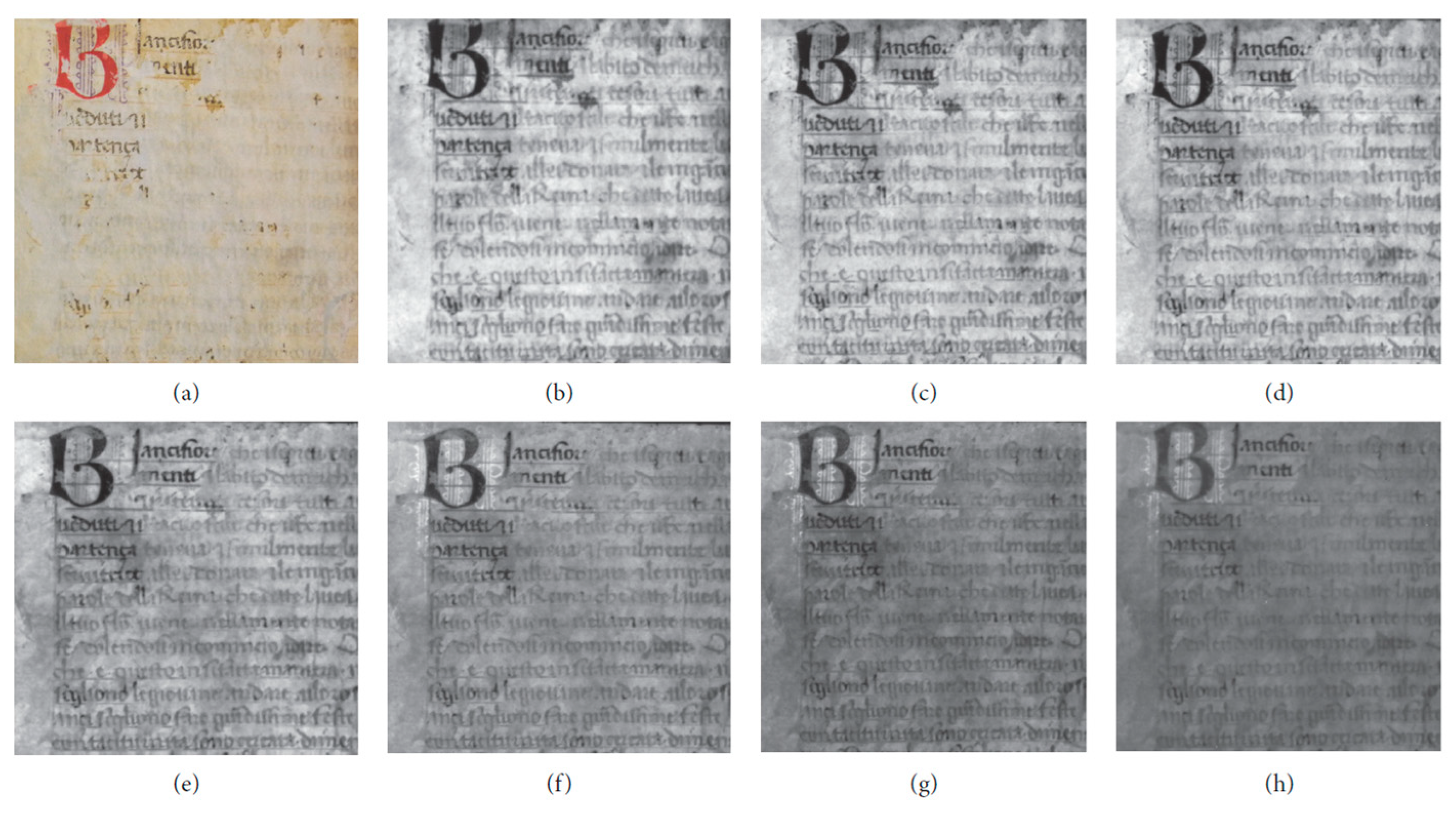
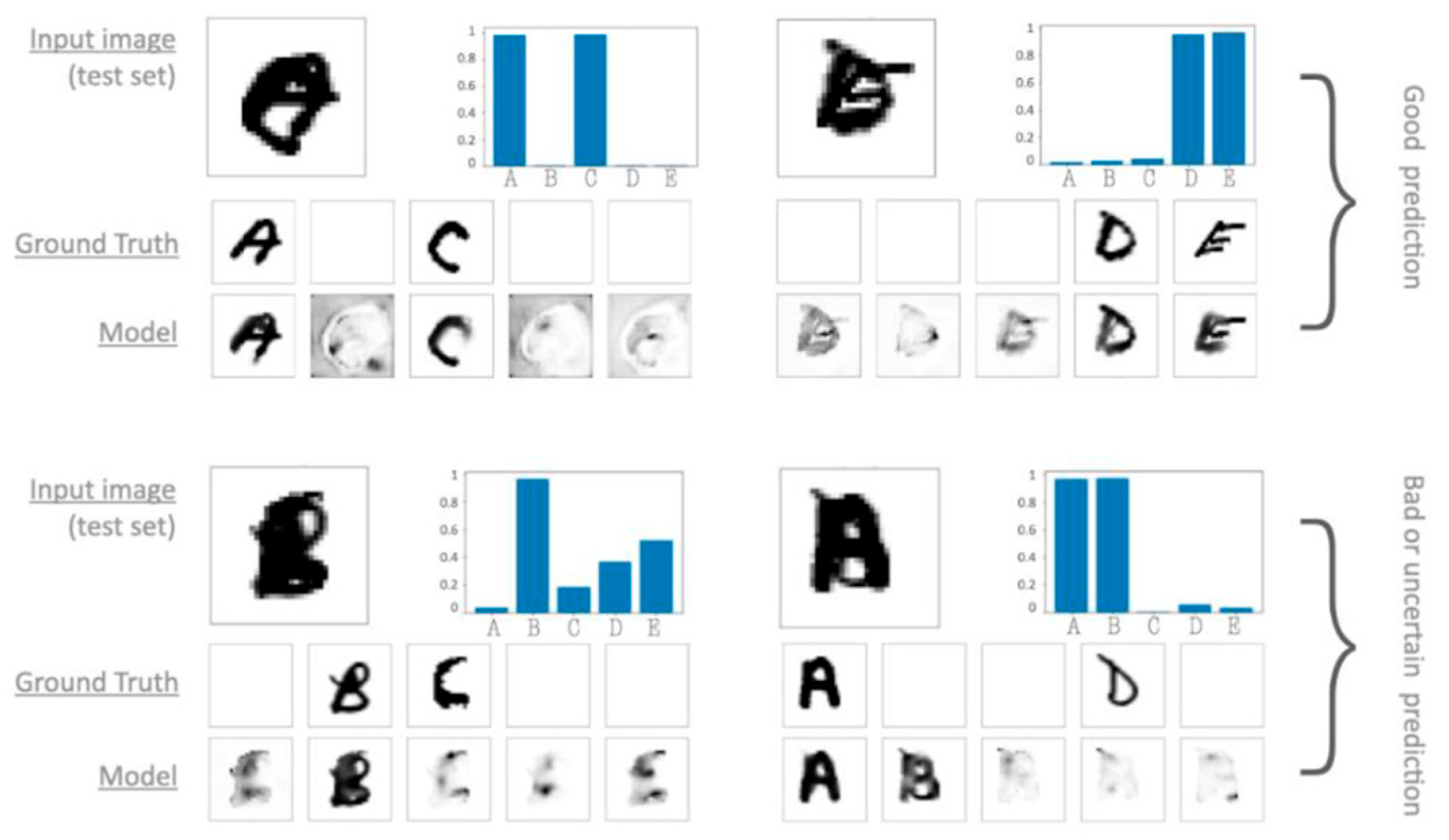
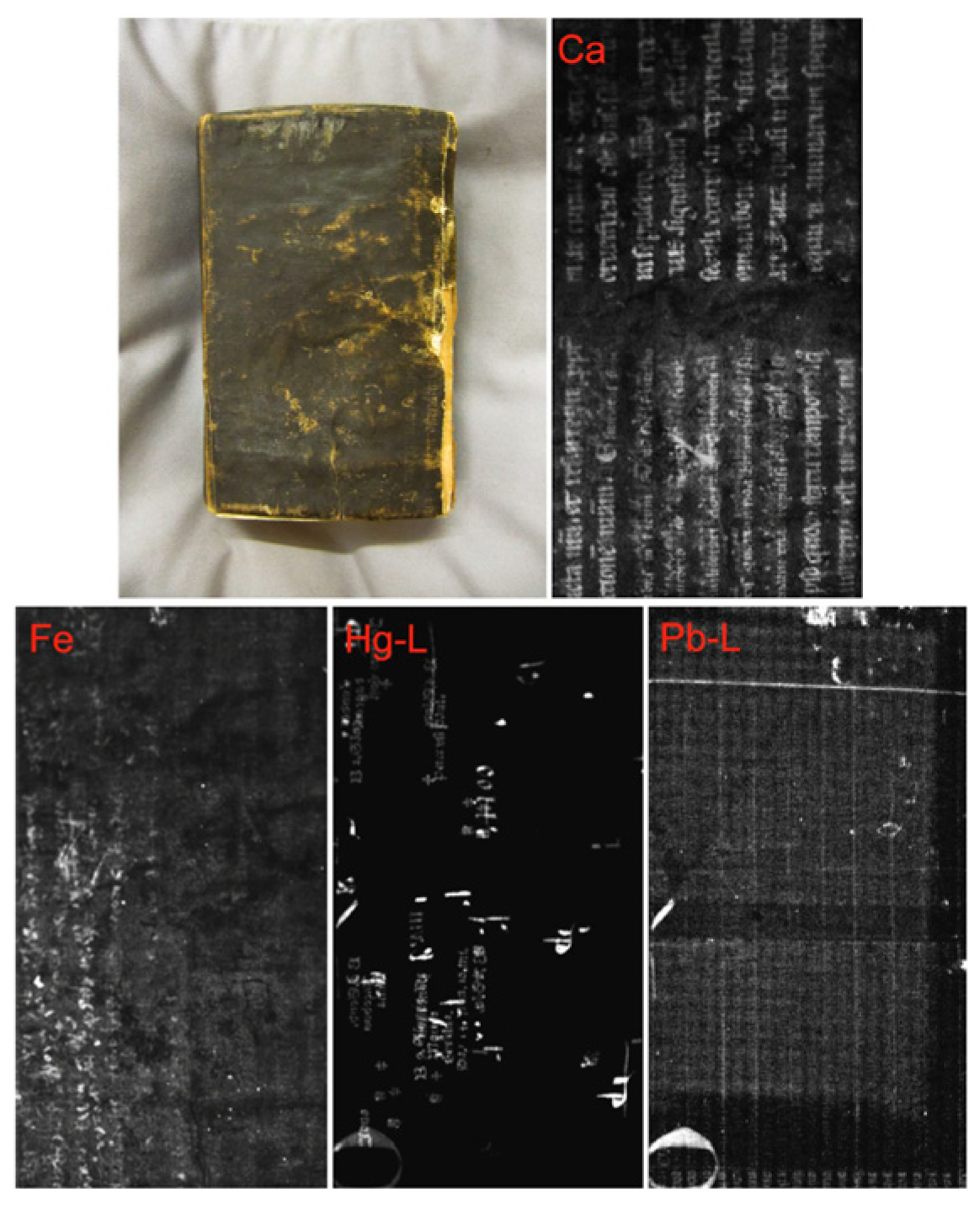
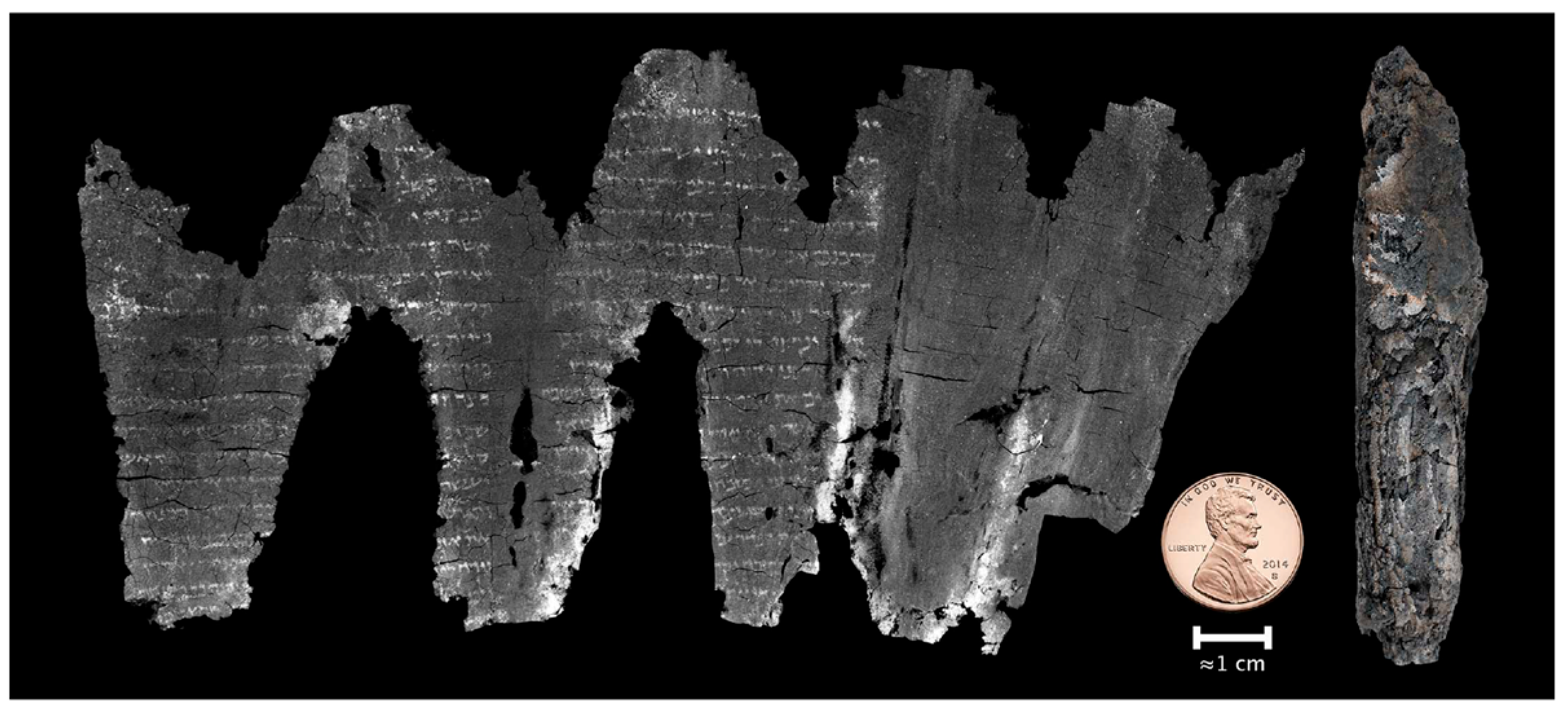
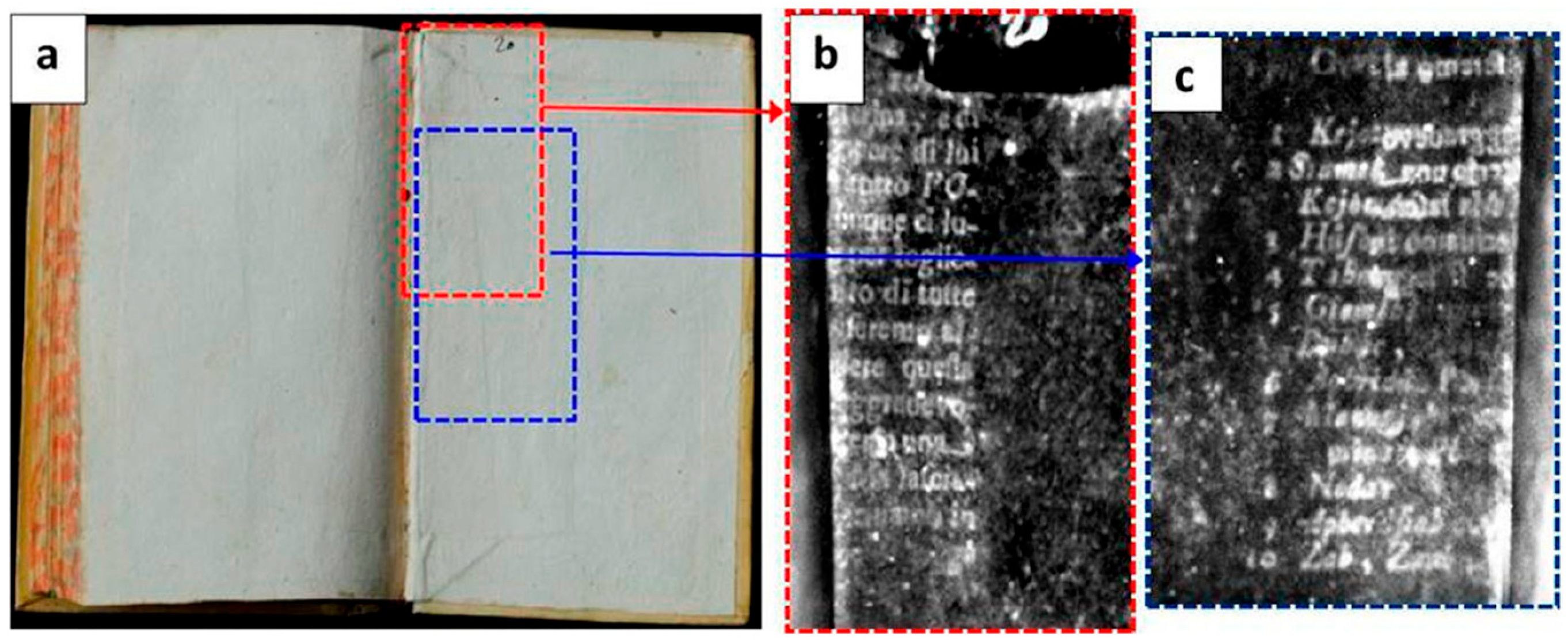


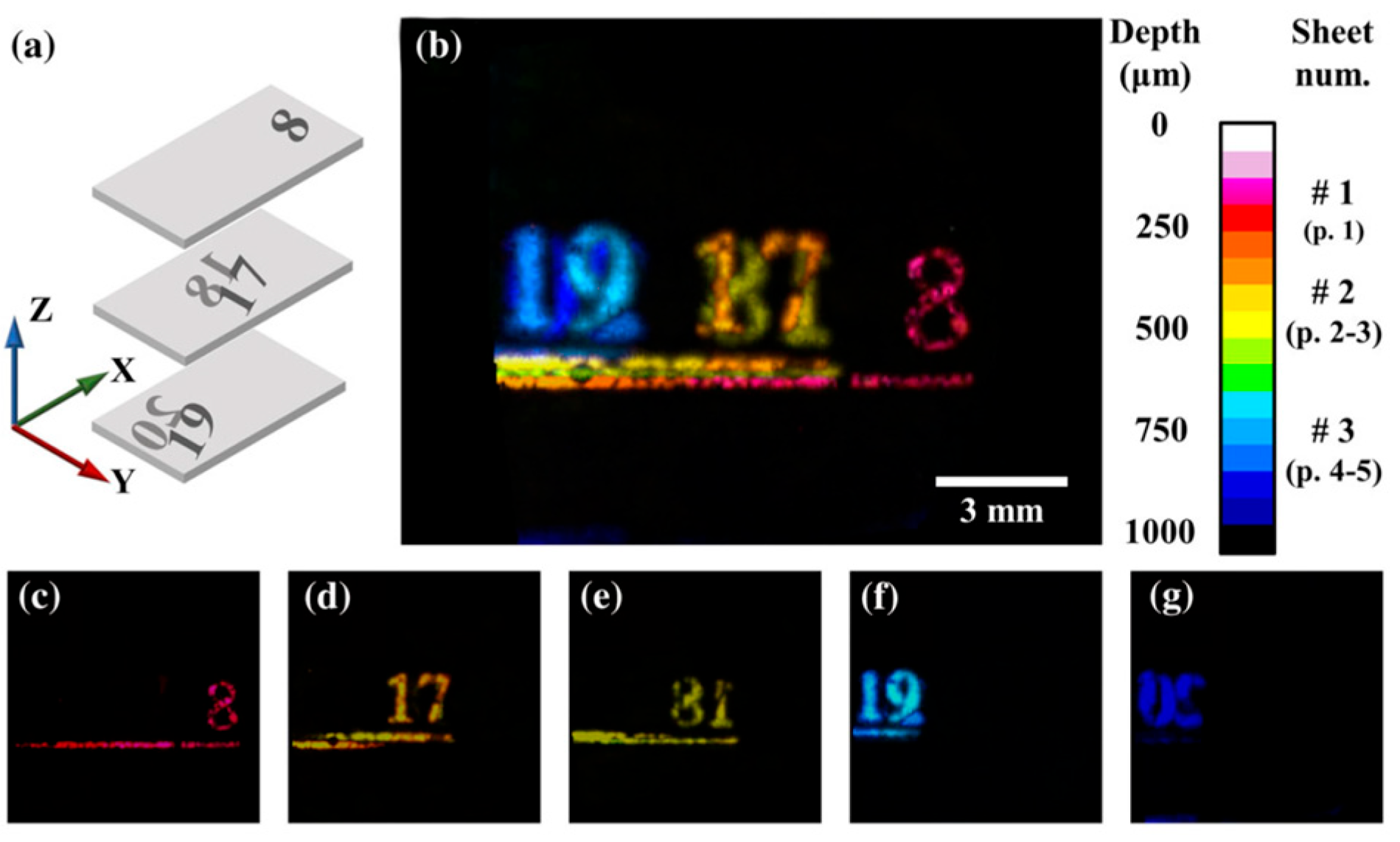
Disclaimer/Publisher’s Note: The statements, opinions and data contained in all publications are solely those of the individual author(s) and contributor(s) and not of MDPI and/or the editor(s). MDPI and/or the editor(s) disclaim responsibility for any injury to people or property resulting from any ideas, methods, instructions or products referred to in the content. |
© 2024 by the authors. Licensee MDPI, Basel, Switzerland. This article is an open access article distributed under the terms and conditions of the Creative Commons Attribution (CC BY) license (https://creativecommons.org/licenses/by/4.0/).
Share and Cite
Perino, M.; Pronti, L.; Moffa, C.; Rosellini, M.; Felici, A.C. New Frontiers in the Digital Restoration of Hidden Texts in Manuscripts: A Review of the Technical Approaches. Heritage 2024, 7, 683-696. https://doi.org/10.3390/heritage7020034
Perino M, Pronti L, Moffa C, Rosellini M, Felici AC. New Frontiers in the Digital Restoration of Hidden Texts in Manuscripts: A Review of the Technical Approaches. Heritage. 2024; 7(2):683-696. https://doi.org/10.3390/heritage7020034
Chicago/Turabian StylePerino, Michela, Lucilla Pronti, Candida Moffa, Michela Rosellini, and Anna Candida Felici. 2024. "New Frontiers in the Digital Restoration of Hidden Texts in Manuscripts: A Review of the Technical Approaches" Heritage 7, no. 2: 683-696. https://doi.org/10.3390/heritage7020034
APA StylePerino, M., Pronti, L., Moffa, C., Rosellini, M., & Felici, A. C. (2024). New Frontiers in the Digital Restoration of Hidden Texts in Manuscripts: A Review of the Technical Approaches. Heritage, 7(2), 683-696. https://doi.org/10.3390/heritage7020034







